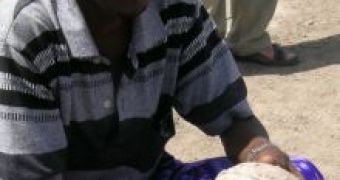An almost complete skull discovered in Ethiopia appears to belong to an ancestor of Homo sapiens that evolved from Homo erectus, thus providing the missing link to modern humans. The fossil (named the Gawis cranium) has been dated as being 200,000 - 500,000 years old, which places it in a little known period called Middle Pleistocene. The fossil record from Africa for this period is sparse and most of the specimens are poorly dated.
"The Gawis cranium provides us with the opportunity to look at the face of one of our ancestors," says the press release of the Gona Palaeoanthropological Research Project at the Stone Age Institute and CRAFT Research Center at Indiana University.
The new hominid skull was discovered by Gona project member Asahmed Humet (photo) while he and his colleagues were conducting archaeological and geological reconnaissance survey in the Gawis river drainage basin in the Afar Regional Administration of Ethiopia. The cranium has been found in a ditch engulfed in recently eroded soft sediments and it includes the braincase, upper face, and upper jaw. Besides the cranium, researchers have also found in the sediment layers many stone tools resembling the tool-making "technology" of the Homo erectus, as well as a significant number of animal fossils including pigs (two types), zebras, elephants, multiple types of antelopes, small carnivores including cats, and numerous rodents.
The fossil could be dated because the region contains many active volcanoes that erupted periodically, covering the local landscape with thin, gray-colored layers of volcanic ash. These volcanic ash layers can be dated precisely. According to Jay Quade, Gona project geologist, this is one of the best-dated human ancestors.
Sileshi Semaw, the Director of the Gona Project, who presented the discovery said: "I am thrilled to have a complete cranium discovered from Gona that can provide key information for understanding the variation that existed during the Middle Pleistocene."
The project paleontologist, Scott Simpson, added that "a good fossil provides anatomical evidence that allows us to refine our understanding of evolution. A great fossil forces us to reexamine our views of human origins. I believe the Gawis cranium is a great fossil."
The scientists hope to find more evidences from this relatively unknown period. Semaw concluded by saying that "I am happy that the Gona project succeeded to make a new hominid discovery from this least known time period in human evolution. Gona is a wonderful site and Ethiopian palaeoanthropology has a lot more to offer to the world. We will keep our heads up and continue our work, and I am optimistic that we will be rewarded with more thrilling discoveries for years to come."
The Gona Project already has an impressive record. They discovered the oldest excavated stone tools in the world, dated to 2.6 million years ago, and early last year they discovered one of the earliest hominids in Africa dated between 4.5-4.3 million years ago.
Credit: Sileshi Semaw/Stone Age Institute

 14 DAY TRIAL //
14 DAY TRIAL //